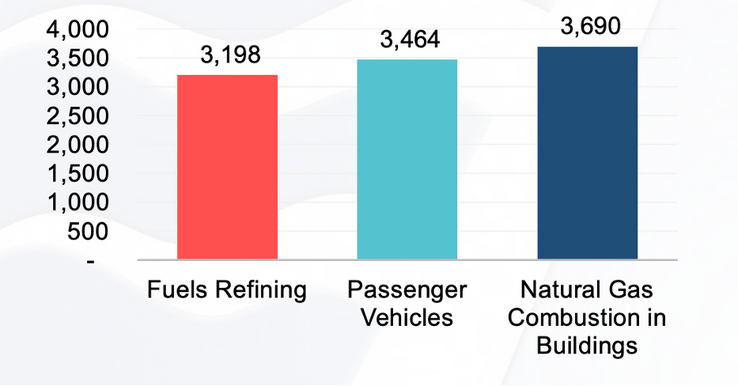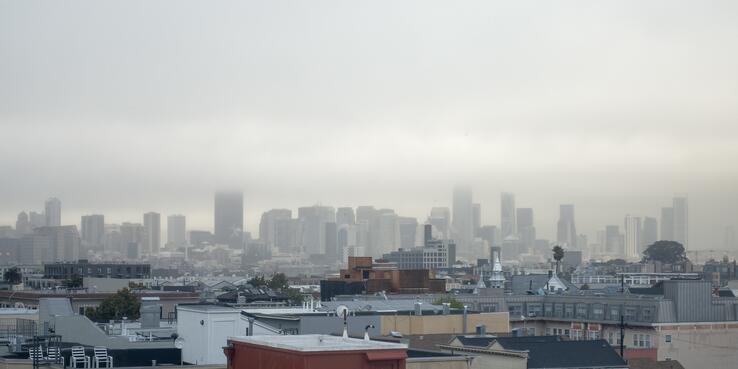Approximately two-thirds of Bay Area households rely on natural gas appliances for space and water heating. These appliances emit nitrogen oxide (NOx), a harmful pollutant. In March 2023, the Bay Area Air District (formerly BAAQMD) amended two groundbreaking rules designed to enhance air quality and public health by regulating sale of NOx-emitting gas furnaces, water heaters, and boilers. These first-in-the-nation rules mark a significant step toward a regionwide transition away from gas-fired water and space heating in homes. Importantly, the regulations will apply only to new, non-cooking gas appliances, meaning residents will not be forced to replace existing, functioning appliances. Moreover, they’ll be phased in between 2027 and 2031.
Timeline for Implementation of Building Appliance Rules
Equipment Type | Compliance Deadline | Requirement |
Residential water heaters using less than 75,000 BTU/hour | Jan. 1, 2027 | Only zero-NOₓ models may be sold or installed. |
Smaller residential and commercial furnaces | Jan. 1, 2029 | Only zero-NOₓ models may be sold or installed. |
Larger residential and commercial water heaters using 75,000–2 million BTU/hour | Jan. 1, 2031 | Only zero-NOₓ models may be sold or installed. |
Source: Bay Area Air District, https://www.baaqmd.gov/rules-and-compliance/rule-development/building-a…
The journey toward clean air in the Bay Area has spanned six decades, beginning with the BAAQMD's regulation of NOx emissions in the 1970s. The more recent NOx rule amendments reflect years of study and public engagement. This long rulemaking effort underscores the importance of a thoughtful implementation process to ensure a smooth and equitable transition away from gas appliances.
The Long Road to Clean Air
BAAQMD began regulating NOx emissions in the 1970s, when studies confirmed the pollutant's role in forming smog and damaging pulmonary and respiratory health. Over six decades, the Air District has moved from targeting NOx emissions from vehicles and large point sources (single, identifiable sources, like smokestacks) to regulating millions of distributed combustion devices, steadily tightening NOx standards to protect health and working toward compliance with National Ambient Air Quality Standards set by the U.S. Environmental Protection Agency (EPA). Despite these efforts, the Air District has spent nearly 30 consecutive years failing to achieve national standards for ozone, and the Bay Area has not met fine particulate matter standards since 2010.
The above-noted 2023 rule amendments followed years of study and public engagement to address the Bay Area’s ongoing air quality crisis. That level of engagement continued after the amendments were passed. The Air District launched an implementation working group for Rule 9-6 (water heaters), holding more than 20 meetings with 40 stakeholders and working with consultants to develop a market readiness report. These efforts will guide development of flexibility measures for resource-constrained residents and residents who encounter exceptional financial or technical challenges in converting to electric equipment. A similar process will begin for Rule 9-4 (HVAC).
By initiating a steady switch from gas-powered space and water heating to efficient zero-emission appliances, rules 9-4 and 9-6 will bring about a market transformation in home heating as distributors and contractors adjust to rising demand for heat pumps. Other clean air regulations have also driven market transformations. In 1973, the EPA took action to phase out lead in gasoline, leading at first to backlash but eventually to innovations (catalytic converters) that radically improved air quality across the country. In 1994, the Montreal Protocol initiated a global phaseout of chlorofluorocarbons, reversing depletion of the earth’s ozone layer and changing markets for thousands of consumer products.
A Multi-Benefit Transition
Gas appliances pose a risk to public health and the planet by emitting pollutants — carbon monoxide, nitrogen oxides, formaldehyde, and fine particulate matter, also known as PM 2.5 — that degrade both indoor and outdoor air quality. Gas-fueled furnaces and water heaters vent combustion gases to the outside, but when ventilation fans (for example, a kitchen range hood) are operating, toxic gases can also draft indoors and harm residents' health.
Nitrogen oxides (NOx) can aggravate respiratory diseases like asthma, leading to respiratory symptoms (such as coughing, wheezing or difficulty breathing), increased susceptibility to respiratory infections, and more frequent hospital admissions and visits to emergency rooms.
PM2.5 is widely known as the most harmful air pollutant in terms of health impacts. It can cause asthma and neurological disease, reduce lung function and impair cognitive development in children, and lead to heart attacks, stroke, lung cancer, and premature death.
When BAAQMD promulgated rules 9-4 and 9-6, it estimated that the rules would help prevent up to $890 million per year in health impacts due to air pollution exposure.
Natural Gas Combustion in Bay Area Buildings Accounts for More NOx Emissions Than All the Region's Passenger Cars
2019 Air District NOx Emissions (in Tons)

Source: BAAQMD Staff Report, Staff Update: Rule 9-6, Board of Directors Meeting, December 4, 2025.
The Bay Area’s NOx rules will reduce environmental as well as health harms. Outdoors, NOx reacts with other chemicals to form acid rain, smog, and particulate matter in the environment. PM2.5 reduces visibility and increases haze, depletes soil, and damages sensitive forest, farm crops, and ecosystems. Moreover, transitioning off gas appliances will reduce the burning of fossil fuels and curb global warming, which is accelerating sea level rise, wildfires, and other climate-related natural disasters.
The Bay Area’s NOx rules ensure significant reductions in both NOx and PM2.5 emissions because the only zero-NOx appliances available are electric appliances. By spurring adoption of heat pumps, the rules will also provide comfort and cost benefits. In the Bay Area, where many homes do not have air conditioning, heat pumps, which double as air conditioners, will help residents cope with rising temperatures and extreme heat events. Because heat pumps are about three times more efficient than fossil fuel systems, they can save residents money on their utility bills. Silicon Valley Clean Energy found that switching from gas-powered space and water heating to heat pumps leads to average bill savings of more than $30 per month.
Implementation To-Dos
The Bay Area Air District’s groundbreaking rules allow policymakers, manufacturers, distributers, installers, and residents to prepare for implementation. Several actions can strengthen the rules’ rollout.
Avoid Unnecessary Electrical Infrastructure Upgrades
Installing new electrical equipment in homes could trigger the need to add new breaker slots or to upgrade electrical panels or even electrical service lines, leading to sometimes significant additional project costs. SPUR’s Solving the Panel Puzzle brief reported that the vast majority of homes use less than 50% of their panel’s capacity and, therefore, could install electric appliances like heat pumps without a panel upgrade. It also reported that full electrification without upgrading is possible even for single-family homes with 100-amp panels. According to a Lawrence Berkeley National Laboratory analysis of TECH Clean California program data, 96% of 1,764 homes with a 100-amp panel could add a heat pump water heater, heat pump HVAC, or both without panel upsizing. Peninsula Clean Energy recently conducted a full electrification case study for nine low-income homes. Every single home — five with 100-amp panels — was able to electrify all appliances without electric service upgrades.
To ensure that contractors and building owners are maximizing their panels and avoiding expensive and unnecessary electrical panel upgrades, program administrators and policymakers should work to spread power-efficient design (PED) strategies. These strategies include the use of low- or moderate-power electric vehicle chargers, 120-volt plug-in heat pump water heaters or heat pump window HVACs, and circuit controllers to manage panel loads. Training pipelines, electrification programs, and utility policies should all aim to incentivize and integrate PED strategies and tools. POWER, a 200-plus member community that has pioneered PED strategies, can act as an informal think tank for decision makers seeking to make electrification easier by maximizing electrical infrastructure.
Support Residents Who Need the Most Financial and Technical Help to Electrify
The upfront cost of purchasing or installing a heat pump is often a deterrent for residents who might otherwise electrify. Programs to address that cost will facilitate an affordable and equitable transition away from gas appliances.
Some financial assistance is already available. Incentives.SwitchIsOn.org alerts homeowners to electrification funding, including local rebates from energy providers and cities and state rebates such as the HEEHRA, TECH, and Golden State rebates. In the Peninsula and South Bay, innovative 0% financing programs offered by Silicon Valley Clean Energy and Peninsula Clean Energy have the potential to scale public funds to reach more customers.
But more homeowner assistance is needed. Local and state authorities should consider polluter-pay fees, tax strategies, public-private partnerships, and other strategies to raise and allocate revenue for electrification programs, thereby ensuring that financially burdened customers don’t have to pay more for a heat pump than a gas equivalent. In the meantime, flexibility in space and water heating rules compliance can ensure residents don’t face undue burdens when financial or technical support is not forthcoming.
Require Well-Timed Upgrades
Some cities are requiring electric upgrades at key points in a building’s life cycle, when renovations are already likely. One option is requiring central AC replacements with heat pumps, which is more cost-effective than furnace replacement and avoids the added cost of a new furnace that many homeowners will soon need. Cities’ efforts through model “reach codes” were complicated by Assembly Bill 130’s six-year building code freeze, though exceptions will likely allow many jurisdictions to move forward with modification.
Eliminate Electrification Hurdles for Homeowners and Installers
SPUR recently published a brief on how cities and state lawmakers can remove permitting and inspection barriers for heat pumps and streamline installation. But ensuring a smoother installation process for heat pumps also requires energy providers, manufacturers, and municipalities to take steps to expand the installation workforce. Novel certification programs like Oregon’s Heat Pump Water Heater certification program could be applied in California. State and local authorities could invest in improved workforce training for both existing and new workforce entrants and could provide incentives for workforce participation in electrification training. Ultimately, the clean energy transition will be driven by a workforce that is trained to install heat pumps and armed with tools, strategies, and streamlined processes to do it cost-efficiently.
